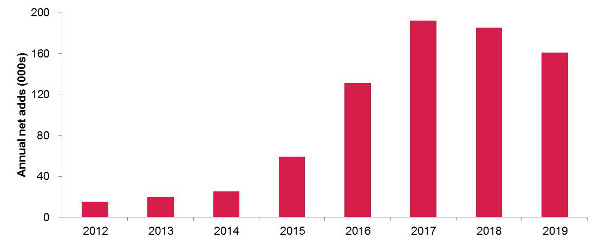Gulf is next streaming video opportunity
Monday, June 29th, 2015
The Next Global Streaming Video Opportunity: Ovum Backs the Gulf
- The audience in the Gulf States offers both youth and an appetite for online entertainment
The launch of the first non-native subscription online video service in the Middle East heralds a new phase in the evolution of the premium OTT video market in the region. Traditional cultural barriers that previously made outside companies hesitant about launching in the region, the core of which is the GCC, are starting to fall and the industry is starting to react.
Ovum profiled the 11 leading premium subscription streaming services in the Middle East and has forecast regional consumer spending on OTT video. It found that, while current spending levels are low at 5% of total global OTT video spending, the sector is primed for rapid growth. The launch of US pay TV network Starz is expected to be the first of many foreign subscription online video (SVOD) providers’ incursions into the region.
Ismail Patel, analyst in Ovum’s TV Practice, comments: “Middle Eastern subscription streaming is set to grow dramatically compared to other regional markets over the coming years. SVOD revenues will grow by over 25% annually to 2019, accounting for over 70% of all OTT revenues in the region. A dramatic increase in subscriber numbers is forecast in the next few years and 2019 will see more than 1 million Middle Eastern subscribers watching streaming services, complementing a growing overall market for visual entertainment.
Long-held reservations when considering a MENA launch are no longer game breakers as censorship controls are relaxed for pay-TV operators and streaming services.”
Middle East: OTT SVOD annual net additions, 2012–19

Source: Ovum
Two-thirds of the world’s Arab population is under 30, making it a prime target for online video entertainment. While there are vigorous free and pay-TV sectors serving the region, there is a dearth of high-quality Western TV and movie content at the low prices offered by subscription streaming.
Current SVOD services in the region overwhelmingly originate from established telcos, pay TV operators, and broadcasters. Ovum believes that non-native services will increase competition in this nascent space and the local services looking to compete will have to invest in original content, a constantly improving user experience, and competitive pricing to maintain market share. Ovum believes that the acquisition of exclusive content is crucial. Whereas live sports will continue to attract the biggest audiences in the Middle East, exclusive movies and high-end dramas can significantly differentiate individual streaming services. Additionally, subscription streaming can target narrow interest groups and monetize niche native and expatriate audiences more effectively than traditional distribution channels whose economics tend to rely on larger audiences.
Credible subscription streaming services with strong content relationships will be well-positioned to grab market share in a rapidly growing sector over the next five years. But market leadership will be hard-won given new service launches during the coming years.
Tony Gunnarsson, senior analyst in Ovum’s TV Practice, says: “In Western markets, SVOD is now a mature business, which is why US broadcasters such as HBO and CBS have launched direct-to-consumer SVOD services. We are experiencing the early stages of the race to pre-empt the entry of global streaming leader Netflix in developing markets across the globe. Netflix is currently committed to achieve global coverage by the end of 2016 with launches in Spain, Portugal, Italy, and Japan planned by the end of 2015.
We expect Starz Arabia to thrive in the MENA region given the quality of its catalog and its timing. It will be under pressure, however, as will the rest of the industry, with the almost inevitable entry of Netflix. As the global expansion of SVOD services continues apace, Ovum believes that there are currently over 100 million SVOD subscribers globally, and that this number will grow to 180 million in 2019.”
Latest News
- Plex has largest FAST line-up with 1,112 channels
- TV3 migrates from on-prem servers to AWS Cloud with Redge
- Virgin Media partners with PubMatic to scale FAST advertising
- Interactive TV news channel unveiled by ROXi and Sinclair
- Spideo and OTTera unveil personalisation collaboration at NAB Show 2024
- Amagi integrates Intertrust DRM for FAST services